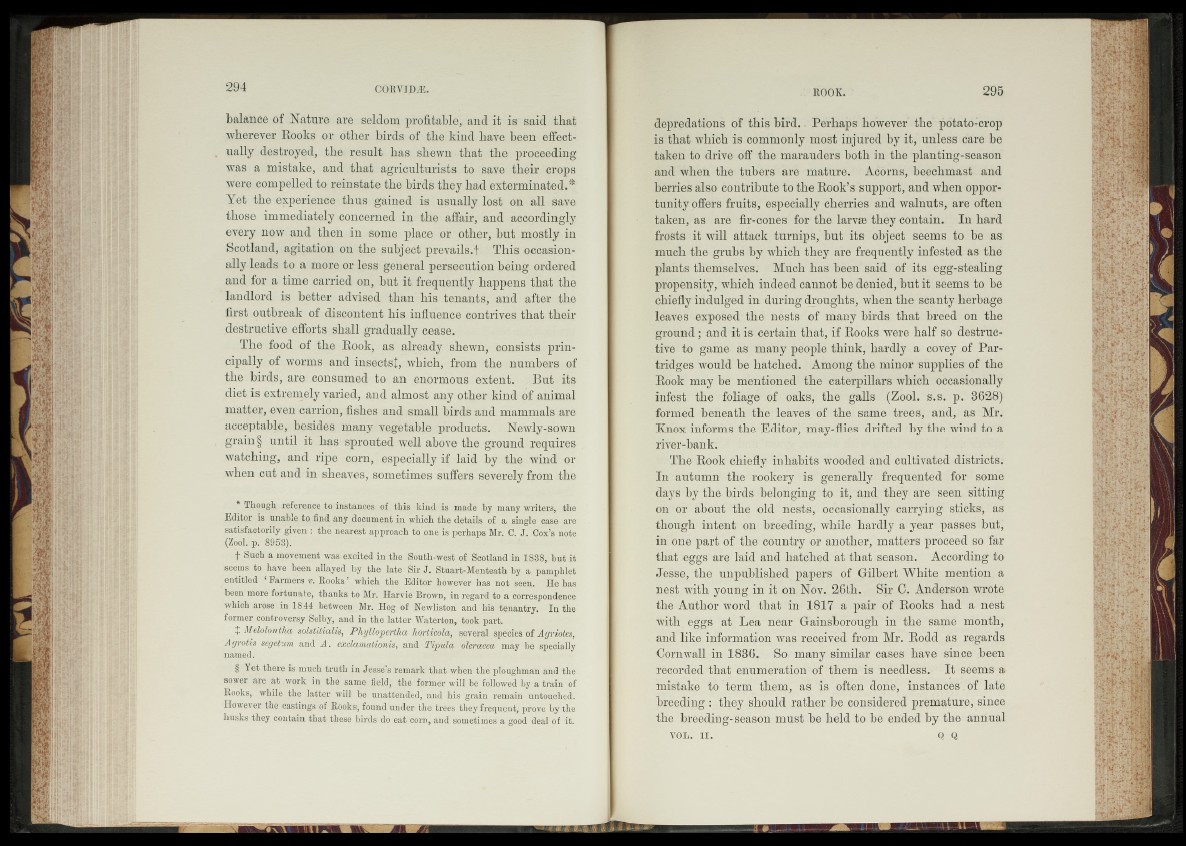
balance of Nature are seldom profitable, and it is said that
wherever Rooks or other birds of the kind have been effectually
destroyed, the result has shewn that the proceeding
was a mistake, and that agriculturists to save their crops
were compelled to reinstate the birds they had exterminated.*
Yet the experience thus gained is usually lost on all save
those immediately concerned in the affair, and accordingly
every now and then in some place or other, but mostly in
Scotland, agitation on the subject prevails.! This occasionally
leads to a more or less general persecution being ordered
and for a time carried on, but it frequently happens that the
landlord is better advised than his tenants, and after the
first outbreak of discontent his influence contrives that their
destructive efforts shall gradually cease.
The food of the Rook, as already shewn, consists principally
of worms and insects!, which, from the numbers of
the birds, are consumed to an enormous extent. But its
diet is extremely varied, and almost any other kind of animal
matter, even carrion, fishes and small birds and mammals are
acceptable, besides many vegetable products. Newly-sown
grain § until it has sprouted well above the ground requires
watching, and ripe corn, especially if laid by the wind or
when cut and in sheaves, sometimes suffers severely from the
Though reference to instances of this kind is made by many writers, the
Editor is unable to find any document in which the details of a single case are
satisfactorily given : the nearest approach to one is perhaps Mr. C. J. Cox’s note
(Zool. p. 8953).
f Such a movement was excited in the South-west of Scotland in 1838, but it
seems to have been allayed by the late Sir J. Stuart-Menteath by a pamphlet
entitled ‘ Farmers v. Rooks ’ which the Editor however has not seen. He has
been more fortunate, thanks to Mr. Harvie Brown, in regard to a correspondence
which arose in 1844 between Mr. Hog of Newliston and his tenantry. In the
former controversy Selby, and in the latter Waterton, took part.
+ Melolontha solstitialis, Phylloperiha horticola, several species of Agriotes,
Agrotis segetum and A. exclamationis, and Tipula oleracea may be specially
named.
§ Yet there is much truth in Jesse s remark that when the ploughman and the
sower are at work in the same field, the former will be followed by a train of
Rooks, while the latter will be unattended, and his grain remain untouched.
However the castings of Rooks, found under the trees they frequent, prove by the
husks they contain that these birds do eat com, and sometimes a good deal of it.
depredations of tbis bird. Perhaps however the potato-crop
is that which is commonly most injured hy it, unless care be
taken to drive off the marauders both in the planting-season
and when the tubers are mature. Acorns, beechmast and
berries also contribute to the Rook’s support, and when opportunity
offers fruits, especially cherries and walnuts, are often
taken, as are fir-cones for the larvae they contain. In hard
frosts it will attack turnips, hut its object seems to be as
much the grubs by which they are frequently infested as the
plants themselves. Much has been said of its egg-stealing
propensity, which indeed cannot be denied, but it seems to be
chiefly indulged in during droughts, when the scanty herbage
leaves exposed the nests of many birds that breed on the
ground; and it is certain that, if Rooks were half so destructive
to game as many people think, hardly a covey of Partridges
would be hatched. Among the minor supplies of the
Rook may be mentioned the caterpillars which occasionally
infest the foliage of oaks, the galls (Zool. s.s. p. 8628)
formed beneath the leaves of the same trees, and, as Mr.
Knox informs the Editor, may-flies drifted by the wind to a
river-bank.
The Rook chiefly inhabits wooded and cultivated districts.
In autumn the rookery is generally frequented for some
days by the birds belonging to it, and they are seen sitting
on or about the old nests, occasionally carrying sticks, as
though intent on breeding, while hardly a year passes but,
in one part of the country or another, matters proceed so far
that eggs are laid and hatched at that season. According to
Jesse, the unpublished papers of Gilbert White mention a
nest with young in it on Nov. 26th. Sir C. Anderson wrote
the Author word that in 1817 a pair of Rooks had a nest
with eggs at Lea near Gainsborough in the same month,
and like information was received from Mr. Rodd as regards
Cornwall in 1836. So many similar cases have since been
recorded that enumeration of them is needless. It seems a
mistake to term them, as is often done, instances.of late
breeding : they should rather be considered premature, since
the breeding-season must be held to be ended by the annual
VOL. II. Q Q